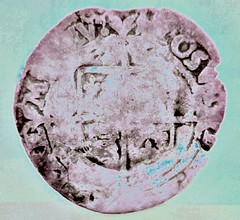1617 -1618 Most sources agree that once Squantum returned to England, he stayed in the home of John Slany, treasurer of the Newfoundland Company. Slany probably hoped to find a native guide to assist with his colonizing ventures. He worked on refining Squantum's English, so that Squantum could be a skilled interpreter. Perhaps he hoped that in Newfoundland, Squantum would be able to communicate with the Beothuk. 1 Squantum was provided with a passage to Cupids (then known as Cuper's Cove) in 1618. John Mason (who was later to become the founder of New Hampshire) was the governor of the colony. Captain Thomas Dermer was in the colony at that time with his friend Governor John Mason. Dermer might have been involved in the fishing trade, but more likely he was involved in exploration of the island's natural resources on behalf of Sir Ferdinando Gorges. He wrote a letter in 1616 from Cuper's Cove (Cupids) in which he describes in flattering terms the fertility of the soil, the abundance of wild life and mineral potentialities. This is evidence that he had an interest in the commercial possibilities of the area. By the time Squantum arrived the colony had been in existence for 8 years. During that time the colonists had learned many survival skills for the harsher climate conditions of the Atlantic cost line of North America. One of the skills they employed was to utilize some of the abundant fish to fertilize the crops. Squantum later taught the Pilgrims to fertilize their crops in this way. 2 The kind of surval skills that he observed colonists using in Newfoundland, coupled with his knowledge of the area where the Plymouth colonists were living, gave him the unique background that would later enable him to help the New England colonists. Captain Dermer, who worked for Ferdinando Gorges, knew Squantum's intelligence and his ability to speak English. He had no trouble persuading Squantum to act as his guide and pilot in further exploration of the New England Coast. In 1618 Squantum accompanied Dermer back to England to confer with Gorges about making the trip to Squantum's home land. In a publication attributed to Sir Ferdinando Gorges, optimism is expressed that Squamtum will be able to help make peace with the Indians of the Coast in New England: 3
1. "The Beothuks." Newfoundland and Labrador Heritage Web Site, maintained by Memorial University. Based on The Beothuks or Red Indians: The Aboriginal Inhabitants of Newfoundland by James P. Howley |
Cupids (Cupper's Cove) Colony - 1610 Cupids, which is the site of the first Official English settlement in Canada (and the second in North America, following Jamestown, Virgina, which was settled in 1607) had been settled in 1610 by John Guy, an experienced merchant from Bristol under charter from King James I. In 2010, Cupids celebrated the foundling of the colony as a year long event which began on New Year's Eve - 2009. John Guy and the 39 colonists who accompanied him had specific instructions. "They were to fortify the settlement at Cupids (Cuper's Cove) in Conception Bay, experiment with farming, cut spars and planks, make salt, potash and glass, collect samples of ore and, significantly, to fish and trade in cured fish and train oil. The first two winters were mild, the death rate was low, and the colonists were able to carry out their instructions. In 1612 Guy brought out 16 women. The company hoped, obviously, that the settlement would eventually become self-replicating. On 17 March 1613 a son was born to the wife of Nicholas Guy (probably a relative of John)." 5
Information about the new Cupids Legacy Centre, opened in 2010> >
 Elizabethan silver four pence. The four pence is the oldest English coin ever found in Canada and dates to between December 1560 and October 1561. For more information about arachaeology at Cupids see the website of the Baccalieu Trail Achaeological Corporation >> 5. Memorial University's Web Site of Newfoundland and Labrador Heritage |